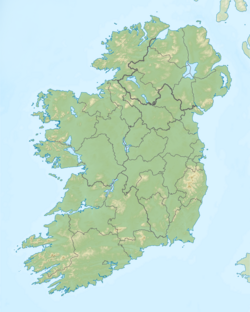Coomsaharn char: Difference between revisions
m Open access bot: doi added to citation with #oabot. |
Removing {{DEFAULTSORT:Salvelinus fimbriatus}} using Cold Default Sort | WP:SORTKEY |
||
| (3 intermediate revisions by 3 users not shown) | |||
| Line 1: | Line 1: | ||
{{Short description|Species of fish}} |
|||
{{speciesbox |
{{speciesbox |
||
| image = |
| image = |
||
| status = VU |
| status = VU |
||
| status_system = IUCN3.1 |
| status_system = IUCN3.1 |
||
| status_ref = <ref name=" |
| status_ref = <ref name="iucn status 12 November 2021">{{cite iucn |author=Freyhof, J. |author2=Kottelat, M. |date=2008 |title=''Salvelinus fimbriatus'' |volume=2008 |page=e.T135411A4125761 |doi=10.2305/IUCN.UK.2008.RLTS.T135411A4125761.en |access-date=12 November 2021}}</ref> |
||
| genus = Salvelinus |
| genus = Salvelinus |
||
| species = fimbriatus |
| species = fimbriatus |
||
| Line 24: | Line 25: | ||
===Name=== |
===Name=== |
||
The English word "char[r]" is thought to derive from [[Old Irish]] ''ceara''/''cera'' meaning "[blood] red,"<ref>{{cite web|url=http://edil.qub.ac.uk/8734|title=eDIL - Irish Language Dictionary|last= |
The English word "char[r]" is thought to derive from [[Old Irish]] ''ceara''/''cera'' meaning "[blood] red,"<ref>{{cite web|url=http://edil.qub.ac.uk/8734|title=eDIL - Irish Language Dictionary|last=|website=edil.qub.ac.uk}}</ref> referring to its pink-red underside.<ref>{{cite book|url=https://books.google.com/books?id=jeeGAAAAQBAJ&q=cierran+char&pg=PA103|title=An Etymological Dictionary of the English Language|first=Walter W.|last=Skeat|date=15 February 2013|publisher=Courier Corporation|via=Google Books|isbn=9780486317656}}</ref><ref>{{cite book|url=https://books.google.com/books?id=gxU39E56bvIC&q=cierran+char&pg=PT578|title=Chambers's Twentieth Century Dictionary (part 1 of 4: A-D)|last=Various|publisher=Library of Alexandria|via=Google Books|isbn=9781465562883}}</ref> This would also connect with its [[Welsh language|Welsh]] name ''torgoch'', "red belly."<ref>{{cite book|url=https://books.google.com/books?id=fj_CAgAAQBAJ&q=cierran+char+fish&pg=RA1-PA282|title=An Etymological Dictionary of Modern English|first=Ernest|last=Weekley|date=5 March 2013|publisher=Courier Corporation|via=Google Books|isbn=9780486122878}}</ref> |
||
Lough Coomsaharn ({{IPAc-en|ˌ|k|uː|m|ə|ˈ|s|æ|h|ər|ən}}) derives its name from the [[Irish language|Irish]] ''Com Sathairn'', "hollow of Saturday(?)".<ref>{{cite web|url=https://www.logainm.ie/en/22283|title=Com Sathairn/Coomasaharn|website=Logainm.ie}}</ref> |
Lough Coomsaharn ({{IPAc-en|ˌ|k|uː|m|ə|ˈ|s|æ|h|ər|ən}}) derives its name from the [[Irish language|Irish]] ''Com Sathairn'', "hollow of Saturday(?)".<ref>{{cite web|url=https://www.logainm.ie/en/22283|title=Com Sathairn/Coomasaharn|website=Logainm.ie}}</ref> |
||
| Line 43: | Line 44: | ||
{{Taxonbar|from=Q5522221}} |
{{Taxonbar|from=Q5522221}} |
||
{{DEFAULTSORT:Salvelinus fimbriatus}} |
|||
[[Category:Salvelinus|fimbriatus]] |
[[Category:Salvelinus|fimbriatus]] |
||
[[Category:Endemic freshwater fish of Ireland ]] |
[[Category:Endemic freshwater fish of Ireland ]] |
||
Revision as of 07:18, 23 July 2022
| Coomsaharn char | |
|---|---|
| Scientific classification | |
| Domain: | Eukaryota |
| Kingdom: | Animalia |
| Phylum: | Chordata |
| Class: | Actinopterygii |
| Order: | Salmoniformes |
| Family: | Salmonidae |
| Genus: | Salvelinus |
| Species: | S. fimbriatus
|
| Binomial name | |
| Salvelinus fimbriatus | |
The Coomsaharn char (Salvelinus fimbriatus; the spellings Coomasaharn and charr are also used; Irish: ruabhreac Chom Sathairn) is a species of lacustrine char fish in the family Salmonidae.[3]
It is only located in Lough Coomsaharn, County Kerry, Ireland.[4][5]
Taxonomy
Name
The English word "char[r]" is thought to derive from Old Irish ceara/cera meaning "[blood] red,"[6] referring to its pink-red underside.[7][8] This would also connect with its Welsh name torgoch, "red belly."[9]
Lough Coomsaharn (/ˌkuːməˈsæhərən/) derives its name from the Irish Com Sathairn, "hollow of Saturday(?)".[10]
Biology
Salvelinus fimbriatus spawns in November/December and feeds on zooplankton. It is distinguished from other Salvelinus in Ireland by large eyes,[11] having 27–30 gill rakers, with 16–20 on the lower part (hence the species name fimbriatus, "fringed").[12] Also, its body depth is 20–25% of snout length, the snout is conical, and the lower jaw is not included in the upper one; an adaptation that helps it to feed on plankton.[13]
History
The Coomsaharn char are a remnant fish of the Last Ice Age.[14]
References
- ^ Freyhof, J.; Kottelat, M. (2008). "Salvelinus fimbriatus". IUCN Red List of Threatened Species. 2008: e.T135411A4125761. doi:10.2305/IUCN.UK.2008.RLTS.T135411A4125761.en. Retrieved 12 November 2021.
- ^ "WoRMS - World Register of Marine Species - Salvelinus fimbriatus Regan, 1908". www.marinespecies.org.
- ^ Stendall, J. A. Sidney; Kertland, Mary P. H. (27 February 1961). "The Irish Naturalists' Journal". I.N.J. Committee. – via Google Books.
- ^ Academy, Royal Irish (27 February 2018). "Proceedings of the Royal Irish Academy: Mathematical and physical sciences" – via Google Books.
- ^ Hendroff, Adrian (30 March 2015). Killarney to Valentia Island – The Iveragh Peninsula: A Walking Guide. The Collins Press. ISBN 9781848895522 – via Google Books.
- ^ "eDIL - Irish Language Dictionary". edil.qub.ac.uk.
- ^ Skeat, Walter W. (15 February 2013). An Etymological Dictionary of the English Language. Courier Corporation. ISBN 9780486317656 – via Google Books.
- ^ Various. Chambers's Twentieth Century Dictionary (part 1 of 4: A-D). Library of Alexandria. ISBN 9781465562883 – via Google Books.
- ^ Weekley, Ernest (5 March 2013). An Etymological Dictionary of Modern English. Courier Corporation. ISBN 9780486122878 – via Google Books.
- ^ "Com Sathairn/Coomasaharn". Logainm.ie.
- ^ MacMahon, Alexander Francis Magri (27 February 2018). "Fishlore: British Freshwater Fishes". Penguin Books – via Google Books.
- ^ Cullen, P.; McCarthy, T. K.; Doherty, D. (2007). "The Coomasaharn char, a morphometrically highly specialised form of Salvelinus alpinus in Ireland". Ecology of Freshwater Fish. 16: 41–46. doi:10.1111/j.1600-0633.2006.00163.x.
- ^ Cullen, P; Mccarthy, T; Doherty, D (1 March 2007). "The Coomasaharn char, a morphometrically highly specialised form of Salvelinus alpinus in Ireland". Ecology of Freshwater Fish. 16: 41–46. doi:10.1111/j.1600-0633.2006.00163.x – via ResearchGate.
- ^ "Ireland - Lake Coomasaharn".


